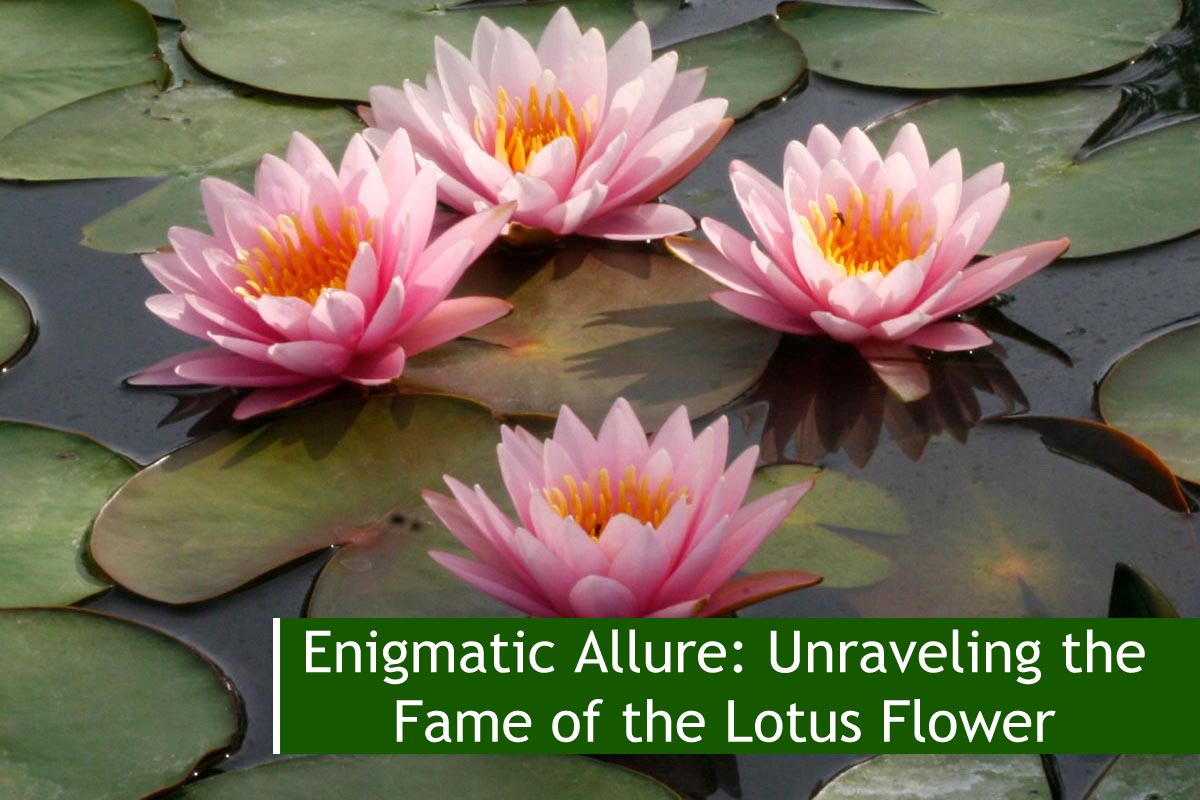
Enigmatic Allure: Unraveling the Fame of the Lotus Flower
The lotus flower means–there’s more than one! Do you know what the lotus represents? The lotus is significant in cultures across the globe, and there are several ways you can interpret the lotus symbol.
In the vast tapestry of the botanical world, one flower stands out with a captivating allure that transcends cultures, spiritual practices, and aesthetic appreciation—the lotus. Revered for its symbolic significance and unparalleled beauty, the lotus flower has achieved global fame that extends far beyond its aquatic habitat. Join us as we unravel the enigmatic allure of the lotus flower, exploring the multifaceted reasons behind its widespread acclaim.
About The Lotuses
The lotus plant, a perennial aquatic marvel, thrives in the nutrient-rich, murky environments of India, East Africa, Southeast Asia, and Australia. Its daily life unfolds with captivating intricacy. Anchoring itself in the mud, the lotus extends its long stems upwards, skillfully navigating the water’s surface. At this elevated vantage point, the plant reveals its most enchanting feature—the lush blossoms. Witnessing the lotus bloom is a spectacle; petal by petal, each emerges immaculate from the murky water, shielded by a protective outer coating that repels dirt and water.
Also Read This : The Ultimate Lotus Tea Guide: Health Benefits and How to Make
These day-blooming wonders have a unique rhythm—they gracefully submerge and close up as night falls, only to reawaken above the water’s surface with the morning sun. It’s a daily dance, a testament to nature’s resilience and adaptability. The lotus petals, though breathtaking, are ephemeral, gracing the world for only a brief span of days before gracefully shedding, making each bloom a precious and fleeting spectacle in the symphony of the lotus plant’s fascinating life cycle.
The Cultural Tapestry
Ancient Symbolism
The lotus has deep-rooted symbolism in various ancient cultures. In Hinduism and Buddhism, it represents purity, enlightenment, and spiritual awakening. The lotus’s ability to emerge untainted from murky waters mirrors the soul’s journey of transcending life’s challenges.
Egyptian Mystique
In ancient Egypt, the lotus held a special place in mythology and religious rituals. It was associated with rebirth and the sun, as its flowers open and close with the sun’s rising and setting.
Also Read This : Unveiling the Secrets to Fix Hibiscus Bud Drop: A Blooming Guide
Aesthetic Beauty
Graceful Elegance
Beyond its symbolic importance, the lotus is celebrated for its unparalleled beauty. With delicate petals that unfold in a mesmerizing display, the flower exudes an aura of elegance and grace that captivates all who behold it.
Versatile Varieties
The lotus family boasts diverse species and hybrids, showcasing various colours, sizes, and shapes. From the classic white and pink to vibrant hues of red and blue, each variety adds to the flower’s allure.
Also Read This : 10 Ways to Elevate Your Home Decor with Adorable Baby Plants!
Environmental Resilience
Aquatic Resilience
Thriving in muddy waters, the lotus teaches us a lesson in resilience. Its ability to grow in adverse conditions, emerging unblemished, symbolizes strength, adaptability, and the potential for beauty to arise from challenging circumstances.
Also Read This : Winter Greenery Secrets: Homemade Liquids to Keep Your Plants Thriving
Spiritual Connection
Meditation and Mindfulness
The lotus has become synonymous with meditation and mindfulness practices. Its presence in serene ponds and tranquil landscapes serves as a reminder to seek inner peace amid the chaos of daily life.
Also Read This : Tiny Wonders: Elevate Your Home Decor with Adorable Baby Plants!
The lotus flower meaning in India
The lotus holds a sacred place in ancient texts and spiritual iconography, spanning from the mystical realms of ancient Egypt to the profound teachings of early Buddhism. Unsurprisingly, the lotus flower has become a potent symbol of the divine. Among the various belief systems, Hinduism, in particular, has woven rich layers of meaning around the lotus. Its presence in Vedic texts, dating back to 1400 BC, attests to its enduring significance.
Within Hinduism, numerous deities are intricately linked to the lotus flower, often depicted holding or surrounded by its ethereal blossoms. The lotus’s symbolism extends beyond religious contexts; it has transcended into the cultural fabric of India. As the national flower, the lotus has gracefully found its place in the country’s arts, culture, philosophy, and religions, becoming a symbol that resonates deeply with India’s spiritual and aesthetic essence.
Also Read This : Harvesting Hibiscus: Tips for Blooming Success
The lotus flower’s fame is not merely a result of its aesthetic appeal but a testament to the profound symbolism it carries across different cultures and contexts. Its enigmatic allure lies in its ability to bridge the spiritual and the visual, offering a source of inspiration, wisdom, and beauty to those fortunate enough to encounter it. As we continue to explore and appreciate the significance of the lotus, we find ourselves drawn into a world where nature’s wonders and human understanding intertwine in harmonious splendour.




